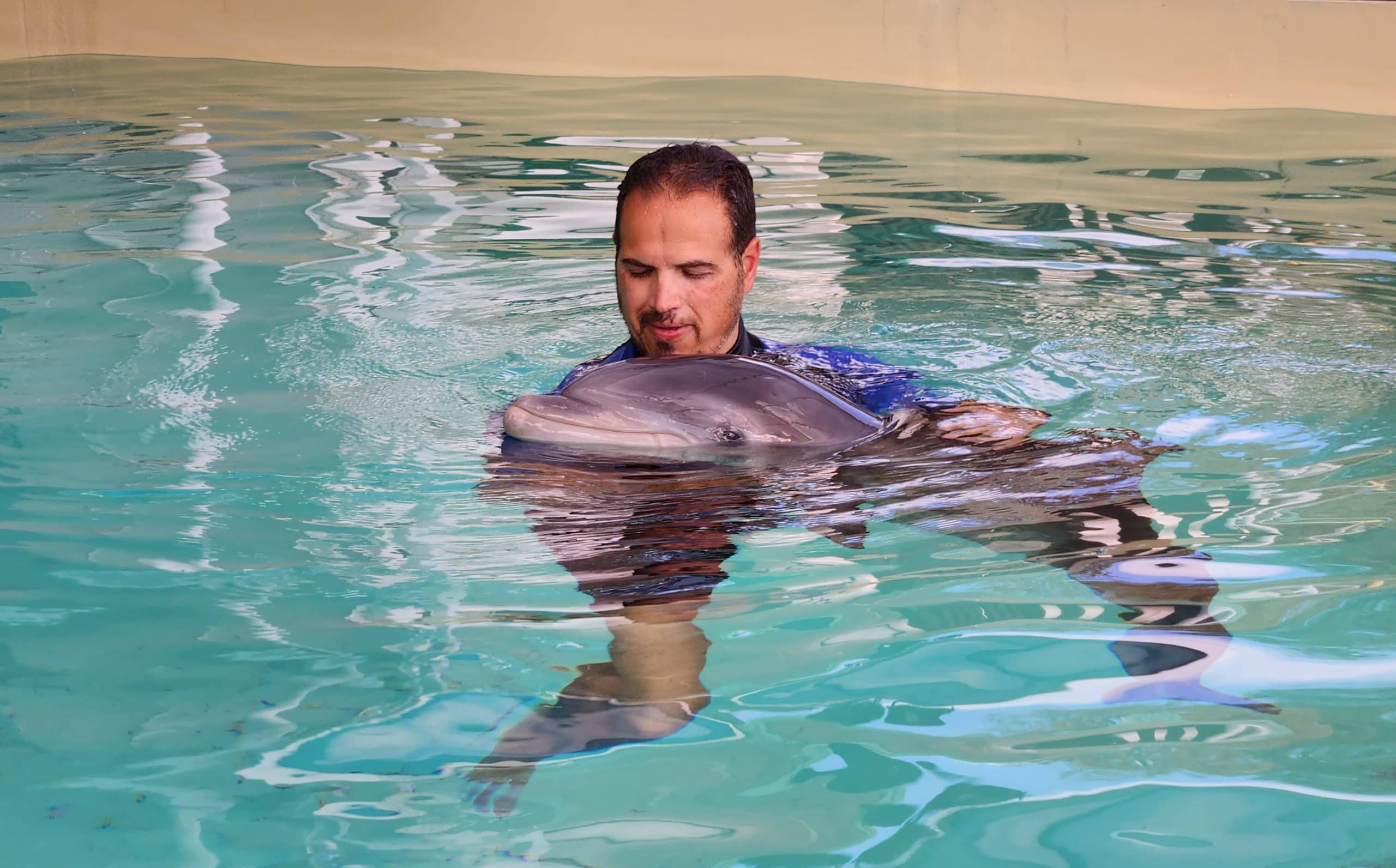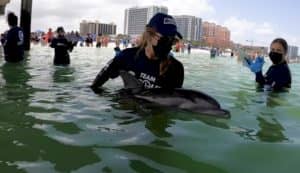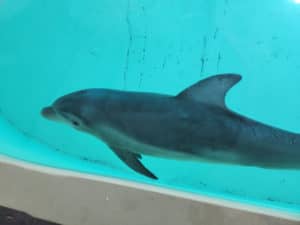Know
A visit with Clearwater Beach’s rescued baby dolphin

Camouflaged by trees, trucks, fences and featureless maintenance buildings, and far from the curious eyes of theme park visitors, is the headquarters of SeaWorld Orlando’s Marine Animal Rescue team. Here the 35,000-gallon stranding pool, half in sun and half in shade under a high white canopy, is home to a seven-month-old bottlenose dolphin, a refugee from Pinellas County.
Measuring 46 inches from nose to tail, the young male’s official name is Ridgway, in honor of a late marine biologist whose dolphin studies were the stuff of legend. The name was announced in mid-October, with much public fanfare.
Team members, who’ve stayed with the little dolphin 24/7 since he arrived in the evening of July 20, aren’t used to calling him that. But they’ll get there, they know.
Senior 1 Animal Care Specialist Nicholas Ricci has worked at SeaWorld for 25 years. He has rehabbed and/or hand-raised at least 20 infant bottlenose dolphins (some of them born at Sea World), along with adults and youngsters of numerous other species that have stranded or been injured.
Ridgway is something special. Even the most serious scientist can’t help but get attached to such a creature.
“I hope I’m not sounding too cheesy, but you see them and you’re just instantly in love,” Ricci says. “This helpless little guy; we want to do everything we can to make sure that he thrives.”

July 20, 2022: A member of the Clearwater Marine Aquarium rescue team with the baby dolphin under Pier 60. Screengrab from CMA video.
Ridgway was three month old and weighed barely 60 pounds when he was discovered under Clearwater’s Pier 60, snared in the heavy vinyl ropes of a crab trap. An adult dolphin sited swimming in circles nearby was, it was believed, the frantic mother. But it swam off as the baby was cut loose from the lines, which were still attached to the heavy trap.
Rescuers from the Clearwater Marine Aquarium kept the weak, frightened animal’s blowhole above water. They realized it could not swim on its own. The National Oceanic and Atmospheric Administration (NOAA) directed the SeaWorld team to retrieve the youngster and drive it to the Orlando rehab facility (destination decisions are made with consideration of timing, experience, and the availability of staff and space).
That first day, Ricci recalls, “he was in really rough shape. For the first 24 hours, we had our pool level at three feet – halfway deep – and we had to be in the water supporting him, walking him around the pool. He could not swim on his own. He could not even keep himself stable. So if we let go of him in the water, he would turn sideways with his blowhole underwater, and be unable to right himself up.”
Although the animal was dehydrated, “he wasn’t terribly skinny; his body condition, in terms of fat on him, was decent. But he had sustained so much damage from that crab trap line, and exerted so much energy trying to get out of it, that he was utterly exhausted.”

Within that first 24 hours, however, there was a ray of hope. “He came in at 7:30 at night, and by 7:40 the next night he started swimming. That’s one of the first signs for us that he has turned a corner. If in three days once a whale or dolphin comes in here, they can’t right themselves up, it’s not a great sign.”
Every day, it seemed, there were small improvements. The baby took to a special formula, created by the SeaWorld team. “He’s still a very dependent calf,” Ricci says, noting that the dolphin drinks 1,900 milliliters of formula per day – in small increments – from a bottle fitted with a makeshift rubber nipple.
He has gained 33 pounds since his arrival, and like all dolphins, is playful and curious.
“His teeth are just starting to erupt. That tells us that he should start to investigate fish. In the next weeks, we’ll begin to introduce fish to him and see if he wants to play with it. If he wants to put it in his mouth and carry it around a little bit, toss it around a little bit. And eventually all that play behavior will lead to him swallowing it at some point.
“Once he begins to swallow that fish, we can start to adjust his diet from all formula to a mix of formula and fish. Until eventually we can wean him off the formula and only do a diet of fish.”

Scars from the crab trap lines are visible from Ridgway’s dorsal fin to his tail.
Ridgway came very close to suffering the same fate as Winter, the rescued dolphin who lived at the Clearwater Marine Aquarium. Circulation to her tail, entangled in trap lines, was cut off – the appendage literally rotted and fell off. Winter lived for 16 years, using a prosthetic tail (most successfully).
Beneath Pier 60, the line that entangled Ridgway went through both sides of his mouth, and down the side of his body to his tail, where it had wrapped around several times. Blood flow was restricted badly enough that his left tail fluke suffered tissue damage, and a small section of it was lost – but not enough to debilitate the animal.
His right eye was scratched by constant rubbing against the taut trap line – he did not open it for two months, but it’s healing with aggressive medical treatment from the team – and there are lateral scars between his dorsal fin and his tail.
He appears to enjoy the daily presence of team members, and will swim to the side of the enclosure – the water is kept at a balmy 79 degrees – for the occasional head or chin rub. He clearly recognizes Ricci.
“As such a little guy, we want to spend as much time with him as possible,” Ricci explains. “After the first 48 hours, we could get out of the water, let him swim on his own. Let him have some quiet time, and then get back in. And we would gradually increase that time.
“Now, we’re always here, so we’re always available to play with him. But now we get in and swim with him in deep water maybe four, five times a day. He responds really well to that.”

Photo by Amy Kagan
Although the goal for every rescue and rehab facility is to release animals back into the wild, Ridgway will never swim free. This is because he was so young when he was discovered and brought to the Orlando facility, he can never learn the behaviors he needs to survive in the ocean.
“Bottlenose dolphins are extremely social. They have a lot of very regional-specific skills to learn, like how to hunt for fish, how to communicate with other dolphins. They learn that from Mom. And we don’t have a way to replicate that information.”
Once he’s big enough to potentially live on his own, Ricci adds, he won’t know how to communicate with wild adults. He’ll be ignorant of the in-place social structure. “And he’s not going to know specifically how to hunt for fish in the Clearwater/Gulf Coast region.”
There’s another thing to consider. “Being social animals, though, the other big hurdle is that they become very imprinted on people. Since we are the ones raising him – right now I don’t have a way for another dolphin to come out and raise him – he has imprinted on people.
“And unfortunately for a dolphin out in the ocean, people are probably the most dangerous thing to them.”
So the next step – once they decide he’s ready – is for Ridgway to join the SeaWorld dolphin population. “There, he’ll meet several adult females, parent figures,” Ricci explains. “And that’s going to be one of the most exciting things for us. And from there, the sky’s the limit.”
There are currently two baby dolphins, with their mothers, in the park’s “nursery pool.” One is just a year old, Ricci says. “We anticipate they’ll be good buddies, and we’ll look forward to when the time for that introduction comes.”
SeaWorld no longer has performing dolphin shows. Many of the animals do, in fact, appear in visitor “experiences,” which the park says are more education than entertainment.
Whatever the future holds, Ridgway won’t be batting beachballs or jumping through hoops for applause.
“We have a lot of dynamic, really interesting habitats for dolphins,” says Ricci. “Honestly, he could go live anywhere. The key that I like to stress with people is that we’re going to make the decision that’s best for him. Whatever he shows us, what’s going to be the most beneficial for him, is where he’s going to go.”









GinnyGomes
January 6, 2023at10:57 am
Thank You for rescuing that baby. You are good people.
Connie Olinger
November 2, 2022at3:44 am
Is Ridgeay Going To Live At Clearwater Marine Aquarium A Long With Hope Nick Hemingway Apollo Rex And Rudolph
Ruth Sell
October 31, 2022at11:24 pm
I am so Happy,they rescue the dolphin. I love Dolphins..I swam with them in Florida..my house is full of dolphin stuff